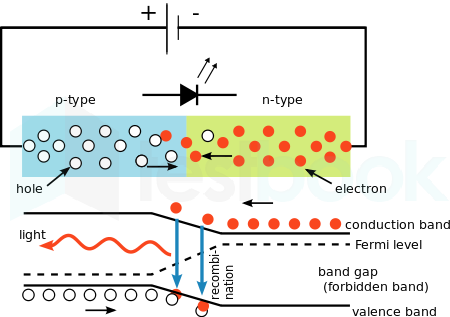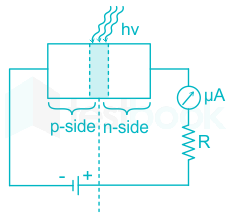Color of Light Emitted by Led Depends on Mcq
The Light-Emitting Diode (LED) MCQ Quiz - Objective Question with Answer for The Light-Emitting Diode (LED) - Download Free PDF
Answer (Detailed Solution Below)
Option 1 : LED
The Light-Emitting Diode (LED) MCQ Question 1 Detailed Solution
Download Solution PDFThe correct answer is option 1, i.e. LED .
- LED is the best source of light that consumes the least amount of energy.
- LED is Light Emitting Diode whichemits light when current flows through it.
- Itreleases energy in the form of photons.
- The filament in an incandescent filament lamp is made of tungsten.
-
The compact fluorescent lamp is a low-pressure mercury-vapour gas-discharge lamp that uses fluorescence to produce visible light.
- It producesshort-wave ultraviolet light.
Answer (Detailed Solution Below)
Option 1 : Forward biased
The Light-Emitting Diode (LED) MCQ Question 2 Detailed Solution
Download Solution PDFCONCEPT :
EXPLANATION :
- When an LED is reverse biased, then the free electrons (majority carriers) from n-side and holes (majority carriers) from the p-side will move away from the junction.
- Due to this, the width of the depletion region increases, and no recombination of charge carriers occur and hence the LED will not emit light.
- That's why LED can operate only in forward bias. So option 1 is correct.
EXTRA POINTS :
Theforward bias and reverse bias:
Answer (Detailed Solution Below)
Option 2 :
electrical energy into light energy
The Light-Emitting Diode (LED) MCQ Question 3 Detailed Solution
Download Solution PDFThe correct answer is electrical energy into light energy .
 Key Points
Key Points
- LED (light-emitting diode)
- The LED (light-emitting diode) is a PN junction device that emits light when a current passes through it in the forward direction, i.e. when LED is forward biased, it emits light.
- In an LED, this energy lies in the visible region of electromagnetic radiation, and the photon released is perceived as light.
- In reverse biased mode, it works like a normal diode and does not emit light.
- It is an optical semiconductor device that emits light when voltage is applied means it converts electrical energy into light energy. Hence, Option 2 is correct.
- When Light Emitting Diode (LED) is forward biased, the free electrons from the n-side and the holes from the p-side are pushed towards the junction.
- Light-emitting diodes emit either visible light or invisible infrared light when forward biased.
- The LEDs which emit invisible infrared light are used for remote controls.
- LEDs that can emit red, yellow, orange, green, and blue light are available for commercial use.

The Light-Emitting Diode (LED) MCQ Question 4
Download Solution PDFWhat is the difference between a CFL and an LED lamp?
1. To produce light, a CFL uses mercury vapour and phosphor while an LED lamp uses semiconductor material.
2. The average life span of a CFL is much longer than that of an LED lamp.
3. A CFL is less energy-efficient as compared to an LED lamp.
Which of the statements given above is/are correct?
- 1 only
- 2 and 3 only
- 1 and 3 only
- 1, 2 and 3
Answer (Detailed Solution Below)
Option 3 : 1 and 3 only
The Light-Emitting Diode (LED) MCQ Question 4 Detailed Solution
Download Solution PDFThe correct answer is 1 and 3 only .
 Key Points
Key Points
- LED bulbs are much more efficient than CFL bulbs in terms of power consumption and life years. Hence Statement 3 is correct and 2 is Not Correct.
 Important Points
Important Points
LED
- LED is known as "Light Emitting Diode".
- A light-emitting diode (LED) is a two-lead semiconductor light source.
- It is a p–n junction diode, which emits light when activated.
- When a suitable voltage is applied to the leads, electrons are able to recombine with electron holes within the device, releasing energy in the form of photons.
- This effect is called electroluminescence, and the color of the light corresponds to the energy of the photon.
CFL
- CFLs contain toxic mercury.
- A fluorescent lamp is a low-pressure mercury-vapor gas-discharge lamp.
- Electrons that are bound to mercury atoms are excited to states where they will radiate ultraviolet light as they return to a lower energy level.
- This emitted ultraviolet light is converted into visible light as it strikes the fluorescent coating on the bulb (phosphor coating).
The Light-Emitting Diode (LED) MCQ Question 5:
Which of the following is the best source of light that consumes the least amount of energy?
- LED
- Filament lamp
- CFL
- Fluorescent lamp
Answer (Detailed Solution Below)
Option 1 : LED
The Light-Emitting Diode (LED) MCQ Question 5 Detailed Solution
Download Solution PDFThe correct answer is option 1, i.e. LED .
- LED is the best source of light that consumes the least amount of energy.
- LED is Light Emitting Diode whichemits light when current flows through it.
- Itreleases energy in the form of photons.
- The filament in an incandescent filament lamp is made of tungsten.
-
The compact fluorescent lamp is a low-pressure mercury-vapour gas-discharge lamp that uses fluorescence to produce visible light.
- It producesshort-wave ultraviolet light.
The Light-Emitting Diode (LED) MCQ Question 6:
An LED is a photodiode which is _______________.
- lightly doped and under forward bias
- heavily doped and under forward bias
- heavily doped and under reverse bias
- lightly doped and under reverse bias
Answer (Detailed Solution Below)
Option 2 : heavily doped and under forward bias
The Light-Emitting Diode (LED) MCQ Question 6 Detailed Solution
Download Solution PDFCONCEPT:
- An LED is a heavily doped P-N junction diode which under forward biased condition emits spontaneous radiations and the wavelength of these radiations falls under wavelength in the visible spectrum.
EXPLANATION:
- When the electric current passed through the LED then the electrons recombine with the holes present in the diode and hence LED emits the light.
- The amount of light emitted will depend on the rate of doping, the diode allows the flow of current only when it is forward biased
- Hence, the LED has to be forward biased and heavily doped
- Hence, option 2 is the answer.
 Additional Information
Additional Information
- Longer life than other electrical light equipments
- Emits monochromatic light
- Environment friendly
The Light-Emitting Diode (LED) MCQ Question 7:
In a photodiode, light is focussed to fall on
- P-region only
- N-region only
- Full P and N regions
- Junction region only
Answer (Detailed Solution Below)
Option 4 : Junction region only
The Light-Emitting Diode (LED) MCQ Question 7 Detailed Solution
Download Solution PDFCONCEPT :
- Photodiode: A photodiode is a p-n junction fabricated from aphotosensitive semiconductor and provided with atransparent window to allow light tofall on itsjunction.
- It is represented by

EXPLANATION:

- From the above diagram, it can be seen thatlight is focused to fall on its junction. So option 3 is correct.
- A photodiode is generally operated in reverse bias condition.
- The light when focused on the junction createselectron-hole pairs that result in the flow of electrons.
The Light-Emitting Diode (LED) MCQ Question 8:
LED is a p-n junction diode which is
- Forward biased
- Either forward biased or reverse biased
- Reverse biased
- Neither forward biased nor reverse biased
Answer (Detailed Solution Below)
Option 1 : Forward biased
The Light-Emitting Diode (LED) MCQ Question 8 Detailed Solution
Download Solution PDFCONCEPT :
EXPLANATION :
- When an LED is reverse biased, then the free electrons (majority carriers) from n-side and holes (majority carriers) from the p-side will move away from the junction.
- Due to this, the width of the depletion region increases, and no recombination of charge carriers occur and hence the LED will not emit light.
- That's why LED can operate only in forward bias. So option 1 is correct.
EXTRA POINTS :
Theforward bias and reverse bias:
The Light-Emitting Diode (LED) MCQ Question 9:
LED is a p-n junction diode which is
- Forward biased
- Reverse biased
- Both forward biased or reverse biased
- Neither forward biased nor reverse biased
- None of these
Answer (Detailed Solution Below)
Option 1 : Forward biased
The Light-Emitting Diode (LED) MCQ Question 9 Detailed Solution
Download Solution PDFCONCEPT :
EXPLANATION :
- When an LED is reverse biased, then the free electrons (majority carriers) from n-side and holes (majority carriers) from the p-side will move away from the junction.
- Due to this, the width of the depletion region increases, and no recombination of charge carriers occur and hence the LED will not emit light.
- That's why LED can operate only in forward bias. So option 1 is correct.
EXTRA POINTS :
Theforward bias and reverse bias:
The Light-Emitting Diode (LED) MCQ Question 10:
Light Emitting Diode (LED) converts ___________.
- light energy into electrical energy
-
electrical energy into light energy
- thermal energy into light energy
- mechanical energy into electrical energy
Answer (Detailed Solution Below)
Option 2 :
electrical energy into light energy
The Light-Emitting Diode (LED) MCQ Question 10 Detailed Solution
Download Solution PDFThe correct answer is electrical energy into light energy .
 Key Points
Key Points
- LED (light-emitting diode)
- The LED (light-emitting diode) is a PN junction device that emits light when a current passes through it in the forward direction, i.e. when LED is forward biased, it emits light.
- In an LED, this energy lies in the visible region of electromagnetic radiation, and the photon released is perceived as light.
- In reverse biased mode, it works like a normal diode and does not emit light.
- It is an optical semiconductor device that emits light when voltage is applied means it converts electrical energy into light energy. Hence, Option 2 is correct.
- When Light Emitting Diode (LED) is forward biased, the free electrons from the n-side and the holes from the p-side are pushed towards the junction.
- Light-emitting diodes emit either visible light or invisible infrared light when forward biased.
- The LEDs which emit invisible infrared light are used for remote controls.
- LEDs that can emit red, yellow, orange, green, and blue light are available for commercial use.

Color of Light Emitted by Led Depends on Mcq
Source: https://testbook.com/objective-questions/mcq-on-the-light-emitting-diode-led--5eea6a1339140f30f369efb2